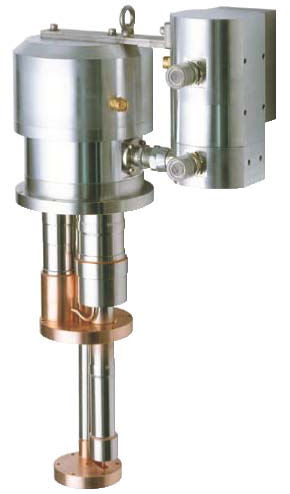Two-stage pulse tube cryocooler
RP-062B (0.5 W at 4.2 K) and RP-082B (1.0 W at 4.2 K)
This two-stage pulse tube cryocooler has a base temperature of below 3.0 K, extending the range of possible applications to include low-temperature, low-vibration applications. The pulse tube cooler has no internal moving parts; therefore, it has inherently low vibration levels.
Standard configuration
Characteristics:
- Refrigeration capacity: 0.5 W at 4.2 K (RP-062B); 1.0 W at 4.2 K (RP-082B)
- Orientation: vertical only
- Push-button operation
Applications:
- Laboratory cryostats
- Cryogenic property measurements
- Optical studies
- Magnetic studies
- Low-vibration

Two-stage pulse tube cryocooler specifications
| RP-062B | RP-082B | |
| Refrigeration cycle | Pulse tube (2-stage) | Pulse tube (2-stage) |
| Refrigeration capacity (vertical position) | 1st stage: 30 W at 65 K (50/60 Hz) 2nd stage: 0.5 W at 4.2 K (50/60 Hz) | 1st stage: 40 W at 45 K (50/60 Hz) 2nd stage: 1.0 W at 4.2 K (50/60 Hz) |
| Orientation | Vertical only | Vertical only |
| Lowest temperature | <3.0 K | <3.0 K |
| Vibration level | ±4 µm at 2nd stage flange | 1st stage: ±7 µm; 2nd stage: ±9 µm |
| Weight | 23.2 kg | 26 kg |
| Cold head dimensions (mm)—approximate | 336 W × 190 L × 604 H | 190 W × 347 L × 581 H |
| Cooldown time (to 4.2 K) | <100/90 min (50/60 Hz) | <80 min (50/60 Hz) |
| Maintenance | Every 20,000 h | Every 20,000 h |
| Compatible compressor unit model | F-50 | F-70 |
| Flexline length | 20 m* | 20 m* |
| Flexline weight | 7.5 kg per line | 7.5 kg per line |
| *Buffer tanks + 6 m lines may optionally be substituted for the 20 m long lines. 6 m lines weigh 5 kg per line. | ||
Specifications subject to change without notice.
Download the Sumitomo's SRP-062B Pulse Tube Datasheet
How do pulse tube cryocoolers work?
Pulse tube cryocoolers operate by utilizing oscillating pressure waves in a sealed tube to transfer heat without requiring moving parts in the cold region. A compressor generates pressure oscillations in helium gas, which flows through a regenerator and into the pulse tube. Heat is absorbed at the cold end and rejected at the warm end through phase-shifted gas motion and thermal exchange. Because there are no moving components in the cold stage, pulse tube cryocoolers offer high reliability and low vibration, making them ideal for sensitive scientific instruments.
What is the difference between a pulse tube and a GM cryocooler?
Both pulse tube and Gifford-McMahon (GM) cryocoolers use helium gas and a compressor to achieve cryogenic temperatures, but they differ in design and performance. GM cryocoolers feature a displacer that moves within the cold head to create the thermodynamic cycle, whereas pulse tube cryocoolers eliminate moving parts in the cold region, thereby reducing vibration and increasing reliability. Pulse tube systems are often preferred for applications requiring ultra-low vibration, such as optical experiments and quantum research, whereas GM cryocoolers are widely used for general cryogenic cooling tasks.
What is the most efficient cryocooler?
Efficiency depends on the application and operating temperature. Pulse tube cryocoolers are considered highly efficient for low-vibration environments because they minimize mechanical losses and maintenance. For general-purpose cooling, GM cryocoolers offer robust performance and cost-effectiveness. In ultra-low-temperature applications, dilution refrigerators or specialized pulse tube systems may offer the best efficiency. Selecting the most efficient cryocooler requires balancing cooling capacity, power consumption, vibration requirements, and temperature range.


